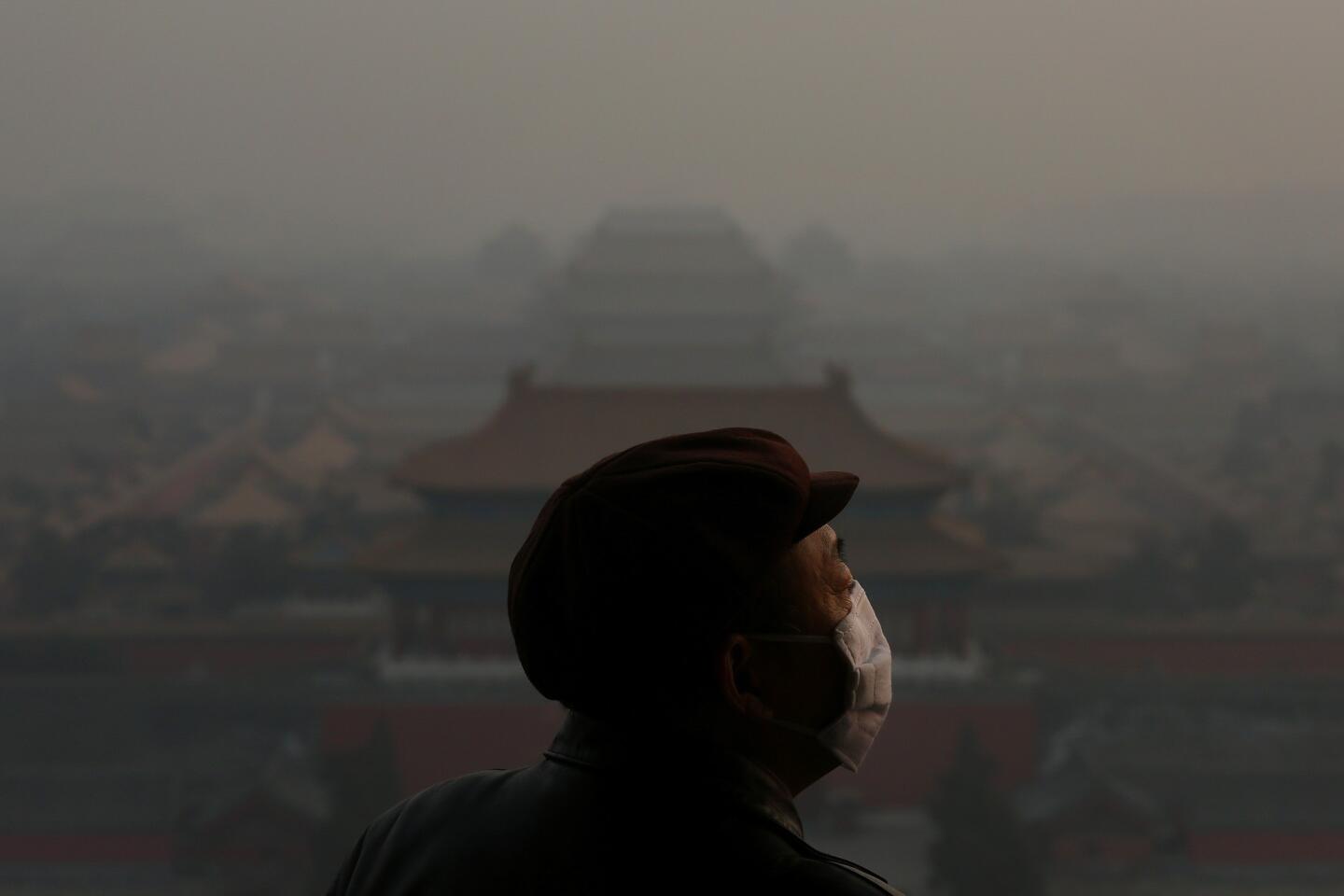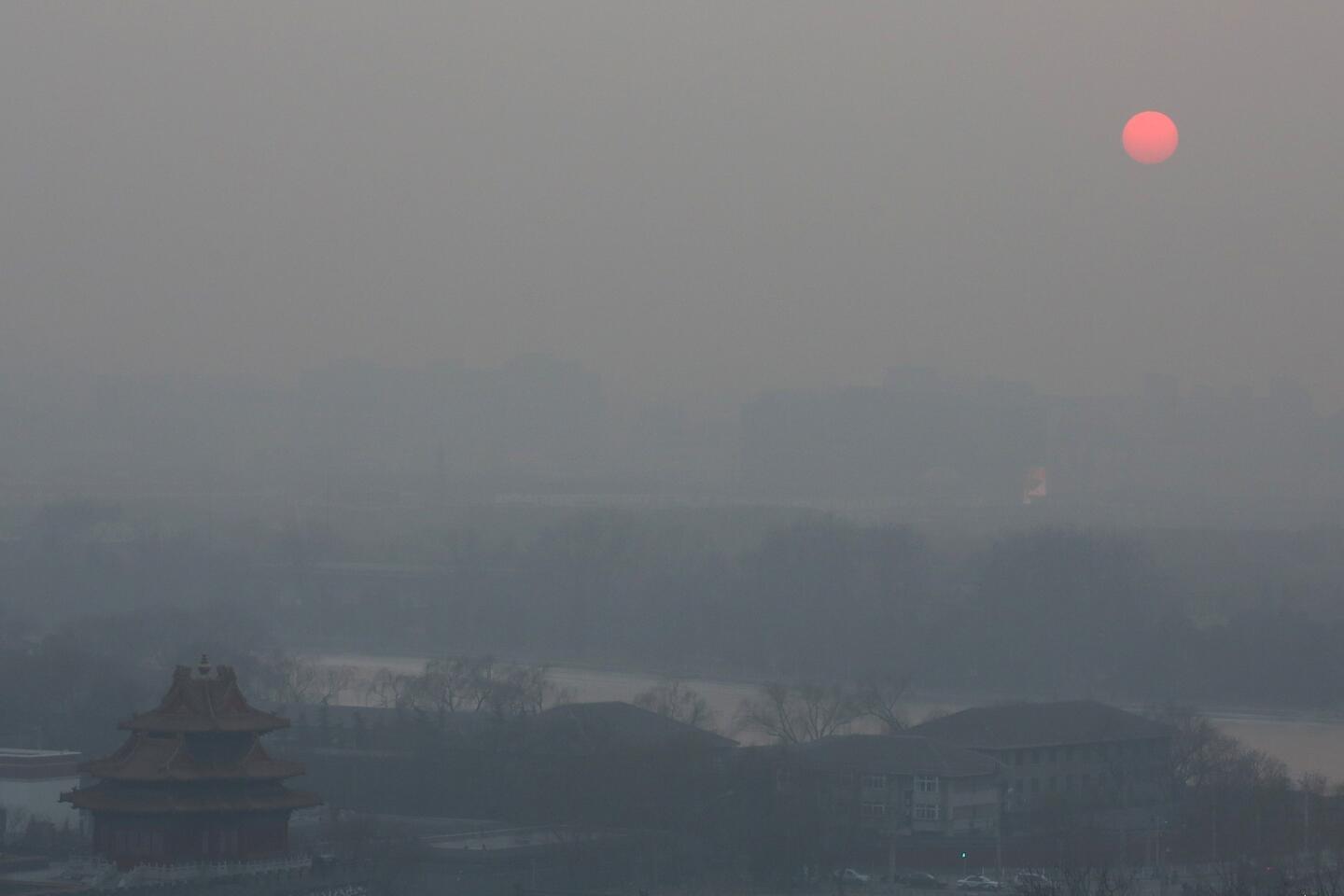The U.S. is abdicating its role as the world’s climate leader. Can China take its place?
- Share via
Reporting from BEIJING — As recently as 2009, China believed that climate action was a Western conspiracy. The U.S. tried to convince Beijing to reduce its emissions of heat-trapping greenhouse gases, and China refused. The U.S., its leaders thought, was simply devising new ways to suppress growth in the developing world.
Since then, the tables have turned. As President Trump rolls back Obama-era climate initiatives, China is not only accelerating its emissions reduction efforts — it’s pressuring other countries, including the U.S., to do the same.
The world is beginning to look toward China as a global leader on climate, and to some degree, China has embraced the mission. Yet there are deep questions about whether the country — the world’s largest emitter of greenhouse gases — has the will, or the ability, to fill a Washington-sized void.
“I don’t think China operates in quite the way the U.S. has,” said Jonathan Pershing, President Obama’s former climate envoy, who now directs the environment program at the William and Flora Hewlett Foundation in Menlo Park. “The United States has got a history of being able to stand up and really cajole, and persuade, and push countries to a common view on global issues. Really nobody else does that quite the way we do.”
The Trump administration’s stance on climate change, environmental activists worry, could be the death knell for the Paris agreement, a historic 2015 accord — championed by the U.S. and China — that aims to avert some of the worst effects of global warming and shift economies around the world to cleaner energy sources
China’s climate advocacy is primarily rooted in domestic priorities, especially cleaning up its noxious air pollution. And the country’s own challenges — its still-extreme air pollution, its bureaucratic rigidity, its relatively inward-looking foreign policy — raise questions about whether China is ready to assume the role of chief international deal maker for the accord.
China’s leaders have “done a pretty good job, as far as we can see from the outside, in living up to the commitments that they’ve made,” Pershing said. “And that’s certainly a good signal, but it’s not the same as trying to build a coalition around a larger vision.”
Under Obama, climate action offered a rare opportunity for diplomatic progress with China — a way to forge agreements despite friction over human rights, cyberattacks, the South China Sea and other areas of conflict. Yet it was not expected to loom large in Trump’s meeting with Chinese President Xi Jinping at the U.S. president’s Mar-a-Lago resort in Florida on Friday — their differing viewpoints leave little room for common ground.
Trump has repeatedly cast doubt on the existence of human-induced climate change; in 2012, he called it a Chinese “hoax.” He has threatened to “cancel” the Paris agreement, as well as the $2 billion in pledges the Obama administration made to the Green Climate Fund, a financial mechanism which aims to help poor countries deal with climate change.
Last week, he signed an executive order directing the federal government to begin the lengthy and complicated process of dismantling Obama’s Clean Power Plan — the landmark federal policy to combat climate change by restricting power plant emissions.
China’s president, meanwhile, defended the Paris agreement in a speech at the Davos World Economic Forum in January. “All signatories should stick to it instead of walking away from it, as this is a responsibility we must assume for future generations,” he said.
China has, indeed, become a global center of gravity on climate initiatives — even for individual U.S. states. “I see Washington declining in influence, but the momentum is being maintained by California and other states aligned with China,” California governor Jerry Brown said in an interview last week, hours after Trump’s executive order on climate change.
Brown will travel to China for the Clean Energy Ministerial, a regular meeting of energy ministers, in June. “California and China will work together,” he said. “I met with President Xi on more than one occasion, and I will continue doing my best to work with and rouse the world community, whatever the politicians in Washington do or don’t do. “
China has made tremendous progress on climate change initiatives in recent years. Its coal use has dropped every year since 2013, and Beijing plans to implement a national market for trading greenhouse gas quotas — a “cap-and-trade” scheme — by the end of 2017.
It has also pledged that by 2030, 20% of the country’s energy mix will come from non-fossil fuel sources, which will require building about the same amount of clean energy capacity in the next 13 years as the entire U.S. electricity grid. Perennially smoggy Beijing shut its last coal-fired power plant in March.
Yet this is only half the picture. “People are sort of cherry-picking the metrics, in how they’re seeing China’s leadership,” said Angel Hsu, a professor at Yale-NUS College who studies China’s environment.
China remains the world’s largest producer of coal, with the fuel comprising nearly two-thirds of its energy mix. In the first five weeks of 2017, Beijing’s average concentration of PM2.5 — particulate matter small enough to penetrate deep into the lungs — was twice as high as the same time last year. Local officials and state-owned enterprises in several northern Chinese provinces boosted steel production, one of the country’s most heavily-polluting industries, primarily to support factory jobs and avoid social unrest.
Although wind and solar energy projects have sprung up nationwide, many remain unconnected to the national grid, and the energy they produce is often wasted.
Xi’s comments on climate change at Davos, Hsu said, haven’t “trickled down.”
“Even though they’ve done well on capacity side, with wind and solar, there’s more that needs to be done,” Hsu said. “And I think they’re looking to the U.S. for leadership.”
Then there’s China’s lack of leadership abroad. Developing nations are desperate for cheap power, and China’s state-owned companies — looking for alternatives in light of tightening environmental regulations at home — are happy to help.
China remains the world’s largest exporter of coal-related financing and equipment to other nations; it invested $25 billion in coal projects worldwide between 2007 and 2015, according to the Natural Resources Defense Council.
In December 2009, Washington and Beijing found themselves on opposing sides at contentious talks at a climate conference in Copenhagen. Unlike some of their U.S. counterparts, China’s leaders have never denied that climate change is a serious problem.
Yet at the conference, its leaders took a position shared by many developing nations: that the developed world got rich through the use of coal, oil and other fossil fuels, so it should shoulder the burden of shifting the world’s economies to cleaner energy.
The conference, an attempt to reach a global accord to fight climate change, descended into chaos and finger-pointing, and was widely declared a failure. China’s lead climate negotiator, Su Fei, accused the U.S. of trying to “evade their historic responsibilities with various excuses.”
But a lot can change within five years, especially in rapidly-growing China. And the country’s air pollution — a miasmic haze that sweeps across huge swaths of the country at least every few weeks — proved to be a remarkable catalyst. The pollution is mainly driven by coal combustion, which is also a major producer of carbon dioxide, the main greenhouse gas.
In 2013, China’s smog problem hit a tipping point. That winter, Beijing’s air was so filthy — grounding flights, packing respiratory wards to capacity — that citizens began complaining openly, forcing the government to respond.
Chinese leaders also saw an opportunity: China could be a major player in new energy, a rapidly growing market worldwide. The country could clean up its skies, and grow richer in the process.
In 2014, Obama and Xi appeared side-by-side in Beijing to announce an ambitious joint plan to curb their countries’ carbon outputs. Xi pledged that China would stop its emissions from growing by 2030, if not sooner. Obama promised that the U.S. would emit at least 26% less in 2025 than it did in 2005.
Without that deal, climate policy experts doubt it would have been possible to persuade many other countries to set targets of their own. A year later, nearly 200 countries adopted the agreement in Paris to fight climate change by reducing emissions.
The Obama-Xi announcement “did actually lead to a seismic shift in climate politics globally,” said Paul Bodnar, senior director for energy and climate change at the National Security Council under Obama.
“It was a pretty impressive kind of cooperation between these two powers and an important, stabilizing influence in the relationship, at a time of turbulence on other issues related to national security and economics.”
United Nations officials have sought to reassure parties to the Paris accord that the deal’s success does not hinge on any one government. In a note to staff members Friday, U.N. climate chief Patricia Espinosa noted, for example, that new research showed that solar power capacity globally grew 50% in 2016, led by the U.S. and China.
“This governmental momentum continues to be underpinned by companies, investors, cities, regions and territories,” she said.
India, which is responsible for 6% of global carbon dioxide emissions, once held a position similar to China’s, blaming Western countries for rampant pollution while arguing that it needed to use fossil fuels to lift hundreds of millions of citizens out of poverty.
But the country, with its drought-plagued agrarian population and long coastline vulnerable to rising sea levels, now has an interest in seeing the Paris agreement survive even without the U.S.
The country has already seen “a remarkable drop” in emissions, said Thiagarajan Jayaraman, a professor at the Tata Institute of Social Sciences in Mumbai, “and that momentum is not going away.”
Kaiman reported from Beijing and Zavis from Los Angeles. Times staff writers Shashank Bengali in Mumbai and Evan Halper in Washington and special correspondents Jessica Meyers, Nicole Liu and Gaochao Zhang in Beijing contributed to this report.
For more news from Asia, follow @JRKaiman on Twitter
Twitter: @alexzavis
A big challenge for the author of ‘The Art of the Deal’ — getting China to rein in North Korea
Climate report card: hot, wild and with an increasingly visible ‘human footprint’
More to Read
Sign up for Essential California
The most important California stories and recommendations in your inbox every morning.
You may occasionally receive promotional content from the Los Angeles Times.













